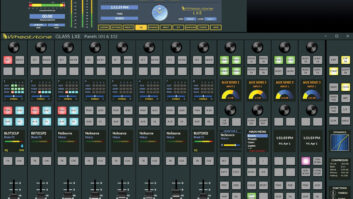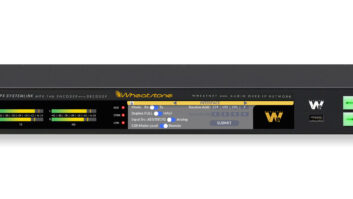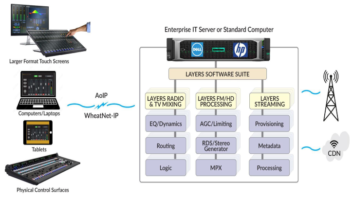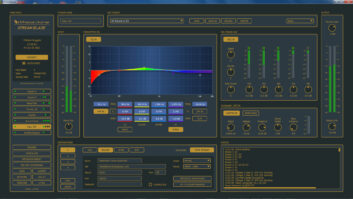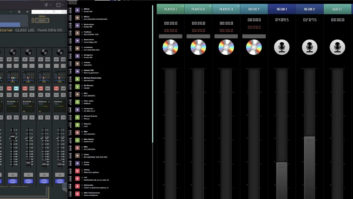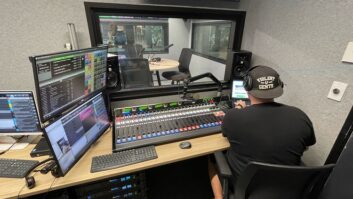(click thumbnail)Phil OwensPhil Owens — Wheatstone Corp.
Q. What kind of products or services does Wheatstone offer for radio broadcasters?
Wheatstone continues to expand upon our large family of networked audio systems and control surfaces. We currently offer four different types of networked I/O frames and at least seven different control surfaces for radio applications. We provide both traditional TDM and AoIP approaches to audio networking.
We are continuing our expansion into the audio processing world with our Vorsis line. We currently have on air processors for FM, FM+HD, AM, general purpose processors for streaming, production work, and a dedicated microphone processor.
Of course, our Audioarts product line continues to provide both analog and digital standalone consoles. We’ve recently introduced smaller analog boards (the Air 1 and Air 2+) that have proven to be very popular and easy to install. Audioarts also has a complete line of networked consoles (the D75N and AENet) that make creating a networked system extremely affordable.
We are still offering studio furniture, accessories and wiring to help streamline the installation process.
Q. What’s new that you will show at the 2008 NAB Show and that radio broadcasters should look for there?
We’ll have additions and enhancements to our Evolution Series of control surfaces, additions to our menu of transport options in an audio network system, new models in the Vorsis processor line and feature enhancements to our existing lineup.
Q. Say I am shopping for a console and networking system, and I’ve been out of the market for the past five years. What will I notice different, what’s the biggest technology change in how these systems are designed today?
Due to the trend toward networked audio systems the design process deals with the entire facility as opposed to individual studios. The larger questions are: 1) What type of audio transport mechanism makes sense for me? 2) What are my core audio sources and how are they shared and distributed? 3) How can I optimize studio usage during different dayparts? 4) How can I provide seamless switching to backup facilities or studios?
After those issues are addressed you address the requirements and workflow of each studio.
Q. What’s the most exciting or unusual project you’ve been involved with lately?
We recently delivered a project for The US Senate that includes two TV Control Rooms, two Radio On-Air Control Rooms, 12 Edit Rooms, and a very large Bridge Network system. The entire system is fully integrated with all sources available to both Radio and TV. It uses our Wheatnet Audio Network switches to achieve a fully redundant audio network.
Q. Where are you based, and how many employees do you have? Anything else we should know about your company?
Wheatstone is based in New Bern, N.C. We have a 52,000 sq ft factory and we employ approximately 100 people. Our factory is state-of-the art, with three surface mount lines, a laser and CNC equipped metal shop, full paint facilities and a furniture fabrication shop. We are a vertically integrated company does everything in house (only our raw printed circuit boards are outsourced). We’re a “Made in the USA” manufacturer that’s been building fine broadcast gear for over 30 years!


(click thumbnail)
Jeff Keith
Jeff Keith — Vorsis Processing Segment
Q. You’ve moved aggressively into audio processing in the past couple of years. What do your processing tools give a radio engineer that he or she can’t do otherwise?
A. It’s interesting that you chose the word “tools” in your question because we’ve designed our Vorsis processors with exactly that word in mind.
We noticed that other processors had a certain ‘sound’ no matter how you tuned them and to our way of thinking it’s wrong for a station to spend a lot of money for a new on-air processor and then have to wrestle with an issue like this — like saying you can have any car on the lot as long as it’s blue. Our view of broadcast audio processors is that they are a tool that allows radio stations to achieve the on-air sound they really want, and that usually means they don’t want to sound anything like the other guy. That meant we had to be very careful to design Vorsis processors so they’re not only powerfully competitive, they’re also clean and natural on the air and have no identifiable on-air “fingerprint.” It also meant we had to invent some new algorithms in order to accomplish our goal.
When you think about it, other products on the market are mostly improvements of their respective company’s rather dated technology. We started with a blank slate and as it turned out, basically ended up reinventing the broadcast audio processor from the ground up. One challenge was bass — everyone has problems with processing bass. So we invented a new technology called the Vorsis Bass Management System, or VBMS, that takes care of that problem, and in fact it allows deeper, cleaner, more detailed bass on the air than other processors and without any of the artifacts.
Another invention was our 31 band limiter algorithm which helps to give the AP1000 unheard of clarity and competitive power on the air. Because the audio spectrum is divided into so many bands, only a small amount of work needs to be done on a per-band basis. And because of the complexity of our implementation and the care we took in designing it there are absolutely no swishing or phasey artifacts when the limiters are in operation. We also gave the HD side of the AP1000 the 31 band algorithm too because it enables it to provide virtually perfect pre-processing for the HD Radio codec.
To make such a powerful processor easy to use, we then created a very unique Graphical User Interface (GUI). The GUI is very intuitive to use and provides a wealth of information related to the audio processing occurring at any instant such as the real-time Fast Fourier Transform (FFT)that shows exactly what frequencies the incoming and processed audio contains. FFT’s are used in other ways within our algorithms to make measurements that different sections of the processor need in order to perform at the superior level that they do.
The sound and on-air performance of our FM processors has been very well received by customers worldwide. We take that and the number of audio processor orders coming in every day as a testament to not only our passion for making good sounding audio processor products, but very powerful ones too.






